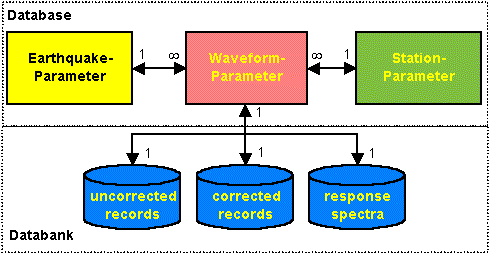|
|
|
The efficient retrieval of strong-motion records is an important task but is not in itself sufficient to answer the needs of the scientist and engineer involved in ground motion or seismic hazard studies and earthquake resistant design. The most important task is the uniform determination of the seismological-, instrumental- and site-specific parameters that characterize the nature of the strong-motion, and which form the basis for the selection criteria of the records to serve different purposes. One of the objectives of a strong-motion database should be to provide data of a very specific nature to scientists and engineers.
There are two keys to effective computer use. One is managing the information; the other is ensuring that information is accessible to users in a cost-effective and secure way. The approach chosen for a computer-based catalogue system is to use a spreadsheet format, which contains data in the easily accessible table form of columns and rows. The most basic system would be to have one record file stored per row, with each column occupied by associated relevant parameters. Such a system would be very inefficient however, because information about the earthquake and the stations would have to be stored several times in the basic spreadsheet. The solution to the problem of duplication is to use a relational database system. A relational database is based on the spreadsheet format, but instead of consisting of a single table there are a number of tables, which are linked to one another. The fields of these tables define unique parameters for each class of data (i.e. earthquake-parameters, station-parameters).
All associated parameters of the strong-motion records archived on this CD-ROM are archived in three different spreadsheets:
|
|
earthquake-database. |
|
|
station-database. |
|
|
waveform-database. |
whereas each component of a strong-motion record is archived in an individual datafile. All uncorrected and corrected time histories and elastic response spectra are archived in three different databanks:
|
|
databank of uncorrected strong-motion records. |
|
|
databank of corrected strong-motion records. |
|
|
databank of response spectra. |
The following figure shows the principle relations between the database and databank:

The primary benefit of such a data-structure is that it significantly standardises the strong-motion records and associated parameters to be presented and, therefore, simplifies the process of searching and presentation. The database- and databank-files are designed for IBM® compatible PCs with Microsoft® Windows 9x, Microsoft® Windows NTx or Microsoft® Windows 2000 as operating system, as well as for programs for viewing of Microsoft® EXCEL 97 spreadsheets and ASCII files, and includes ~605MB of data, programs and code.
|
|

The following pages give a complete description of the database-parameters:
|
|
earthquake-parameters |
|
|
station-parameters |
|
|
waveform-parameters |
|
|